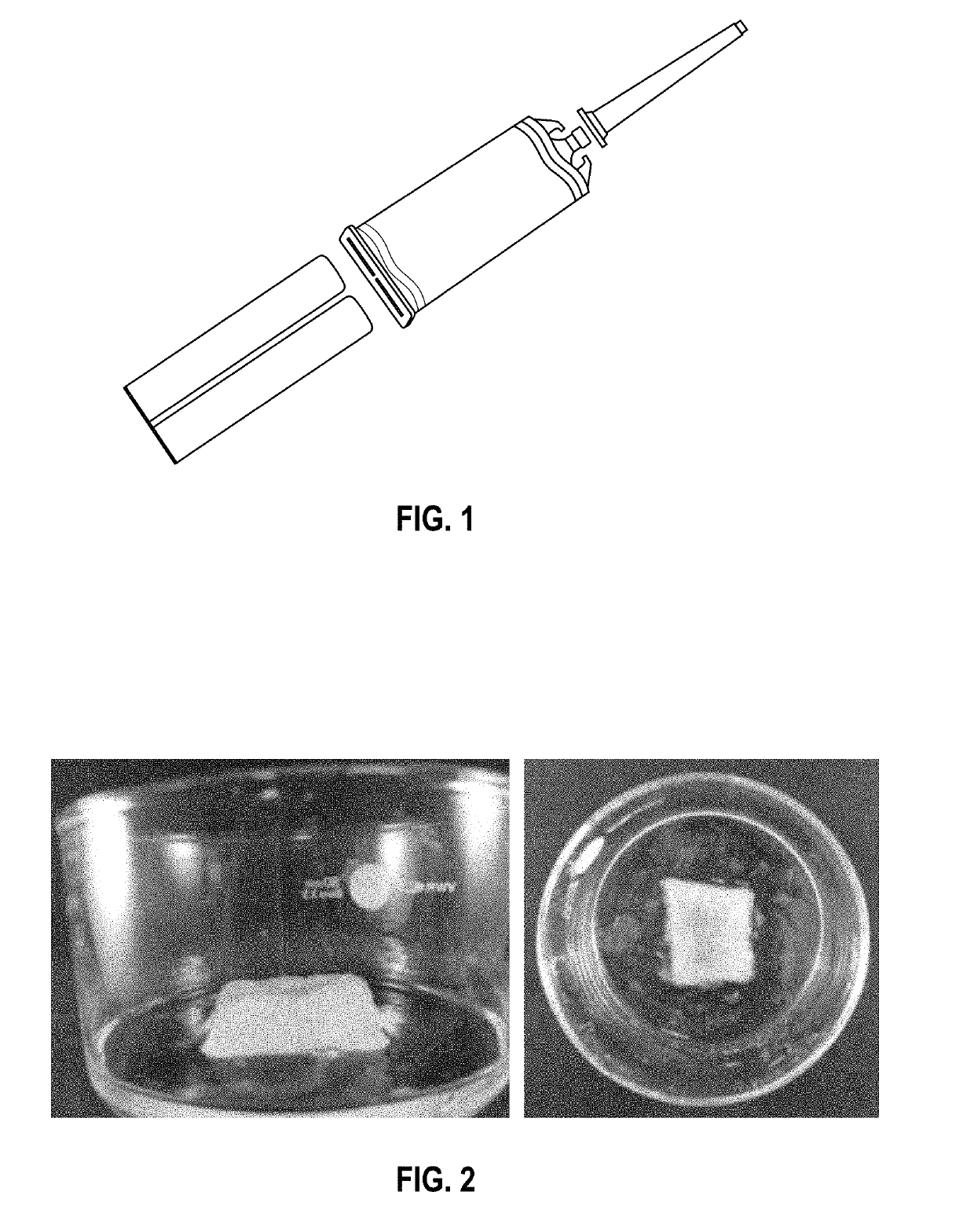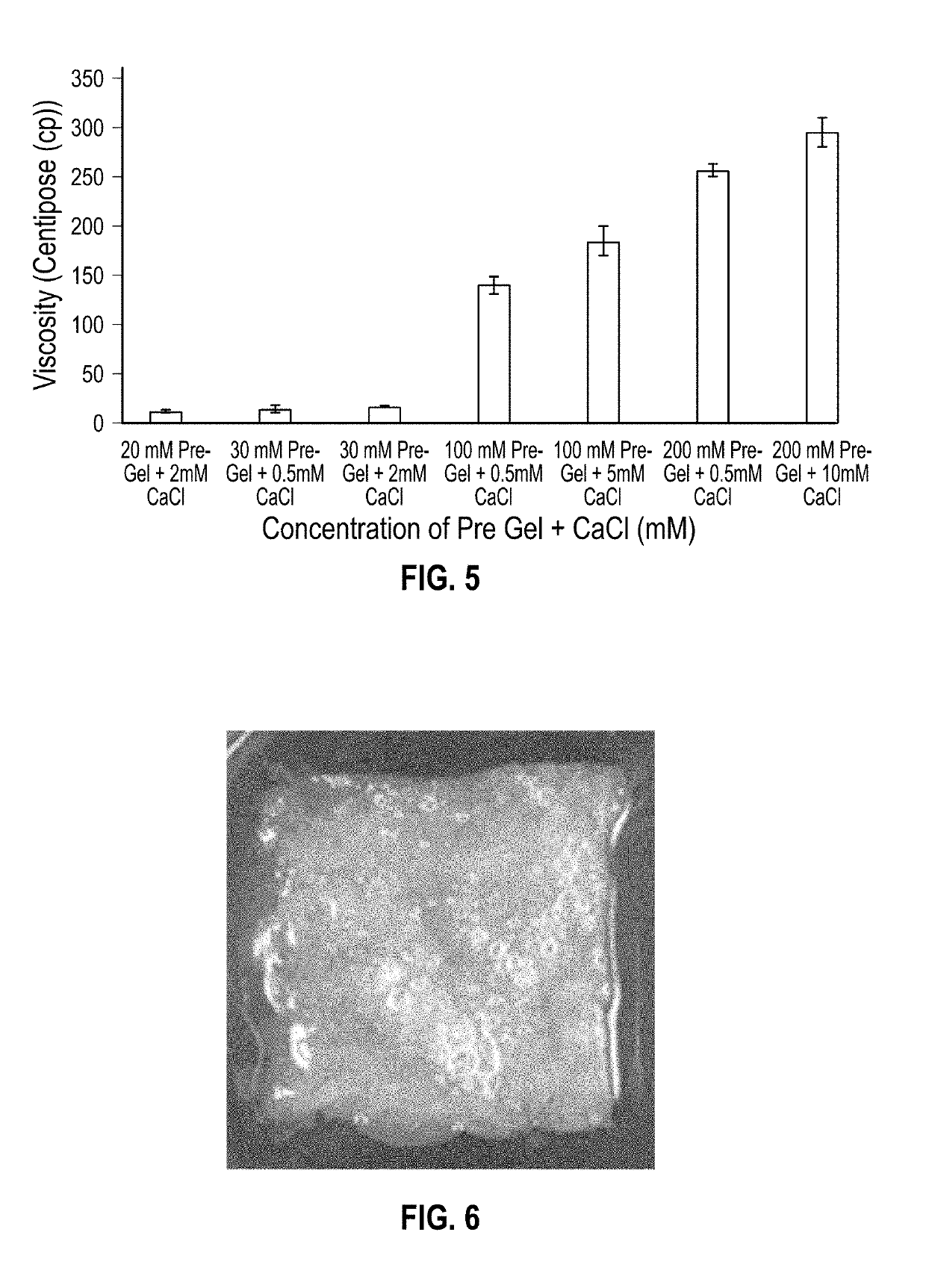3D Printing and Drug Delivery
- Summary
- Abstract
- Description
- Claims
- Application Information
AI Technical Summary
Benefits of technology
Problems solved by technology
Method used
Image
Examples
specific embodiments
[0128]In specific embodiments of the invention optional and preferred features of the invention are combined into particular compositions. The gels are used for 3D printing or as cell support structures or for sustained active agent delivery.
[0129]Selected specific embodiments comprise gels composed of di-peptides linked to an ASL, cross linked by divalent cations having a stiffness of 5 kPa or higher at a pH of 6-8.
[0130]Further selected specific embodiments comprise gels composed of mixtures of di-peptides linked to an ASL, cross linked by calcium and / or magnesium ions having a stiffness of 5 kPa or higher at a pH of 6-8, with stiffer embodiments having a stiffness of 10 kPa or higher.
[0131]In one set of specific embodiments the gel comprises a mixture (e.g. of from 1:5 to 5:1, preferably from 1:2 to 2:1, more preferably approximately 1:1) of
[0132](a) Fmoc-FF and one or more of:
[0133](b) Fmoc-S (i.e. yielding a mixture of a dipeptide and a mono-peptide), Fmoc-FF (i.e. the gel is p...
example 1
[0188]Two methods of printing using hydrogels were investigated. The first used pre-gel mixed with CaCl2 solution to produce a partially crosslinked material which was dispensed into a concentrated CaCl2 solution to rapidly fully gel the material in a 3D structure. The second comprised dispensing pre-gel with CaCl2 solution via a double barrel syringe to immediately cause cross-linking and for a 3D structure to be created.
[0189]Preparation of the Solutions.
[0190]Hydrogel Precursor Solution
[0191]Fmoc-FF / S (i.e. a mixture of Fmoc-FF and Fmoc-S) lyophilised powder (batch produced using 91% pure Fmoc-FF for investigation purpose only) was weighed into a 50 mL tube, which had been tared on the balance. To obtain hydrogel precursors with concentrations of 10, 20 and 30 mM, 0.22, 0.44 and 0.66 grams were used and reconstituted in sterile water. Thorough mixing and sonication for 30 seconds was performed using the vortex and sonicator water bath. Pre-gels were stored at 4° C. until further ...
example 2
[0210]Following on from Example 1, a second experimental procedure was devised and used to dispense pre-gel and CaCl2 solution from two separate syringes through a 3-way connector (see FIG. 3). The two components were dispensed through the third opening on the connector via a 1 mL pipette tip, which had been attached. The gel material produced was tested for rheology over a 5 hour period to demonstrate short term stability.
[0211]Having identified the concentration of calcium chloride solution required to initiate quick gelation of the peptide derivatives, initial investigation into the mechanical properties of the structures formed under these new conditions was carried out, and an assessment of the tunability of the new bio-ink.
[0212]With regards to specific mechanical properties that were studied, initially the viscosity of the bio-ink was investigated as this is a key component in determining its compatibility with 3D bioprinting techniques.
[0213]The stiffness of the fully cross-...
PUM
| Property | Measurement | Unit |
|---|---|---|
| Time | aaaaa | aaaaa |
| Time | aaaaa | aaaaa |
| Pressure | aaaaa | aaaaa |
Abstract
Description
Claims
Application Information
 Login to View More
Login to View More - R&D
- Intellectual Property
- Life Sciences
- Materials
- Tech Scout
- Unparalleled Data Quality
- Higher Quality Content
- 60% Fewer Hallucinations
Browse by: Latest US Patents, China's latest patents, Technical Efficacy Thesaurus, Application Domain, Technology Topic, Popular Technical Reports.
© 2025 PatSnap. All rights reserved.Legal|Privacy policy|Modern Slavery Act Transparency Statement|Sitemap|About US| Contact US: help@patsnap.com



